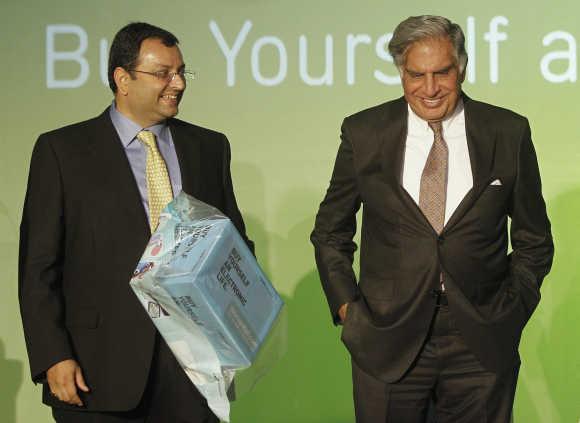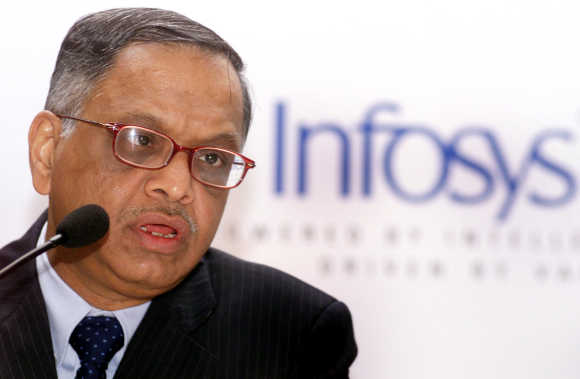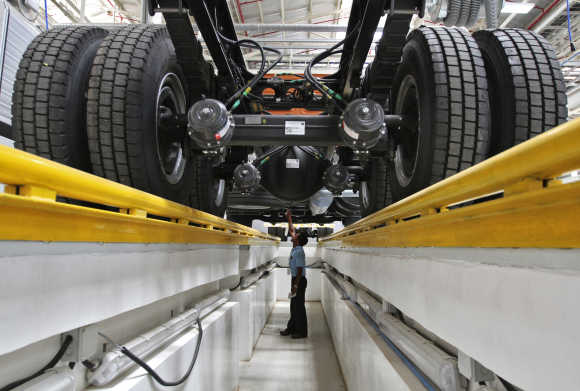Photographs: Vivek Prakash/Reuters Sayantani Kar
Developing a deep bench is a human resource issue, not restricted to the top management, but spanning an organisation's hierarchy.
In most global organisations, leadership development initiatives are considered an integral part of the corporate strategy.
Are Indian corporations using global best practices to plan succession? Does India Inc have sufficient "ready now" candidates to replace planned and unplanned losses of key leaders? Our panel of experts offer some answers.
There's a need to view succession planning as a talent development process - Indranil Roy
India Inc has a significant succession issue. Partly due to leadership demographics, an entire generation of leaders and first generation entrepreneurs are going to retire over the next five to 10 years, paving the way for a new generation of executives.
This in itself is a significant challenge. Add to this the fact that India's economic growth has created a huge demand for executives, straining the pool of available executive talent in the country, especially with Indian executives finding lucrative global roles in multinationals.
Finally, the aspirations of young talent is changing rapidly with an increasing number of young leaders choosing to either start their own businesses or move out of the corporate sector altogether and work in the non-government sector. These three trends, taken together is creating a significant succession challenge in India.
India Inc. has had a long history of building talent for the future. Several global studies have identified Indian companies like the Tata Group, Infosys, ICICI, Wipro, Hindustan Unilever, Aditya Birla Group and others as global leaders in the arena of talent and leadership development.
So, in theory, Indian companies should not have an issue navigating the shift in executive ranks from one generation to the other.
...
How good is succession planning in Indian cos?
Image: Narayana Murthy.Photographs: Punit Paranjpe/Reuters
At the most visible end of the spectrum, with celebrity succession cases like Ratan Tata, Narayana Murthy, etc that seems to be the case. We have been witness to very careful and meticulous succession planning from major corporations like the Tata Group, Infosys and ICICI in the recent past.
That said, the vast majority of companies in India are still struggling with the idea of smooth handover across generations.
There are three main reasons based on the type of company:
i) Promoter-led businesses: Succession planning in first generation promoter-led businesses is difficult anywhere in the world. The founder tends to have an outsized impact on the culture, values and the operating style of the company, making it difficult even for the best of executive talent to fully replace the founder.
We have witnessed this in Dell and Starbucks where, even with a solid bench of talent, the founder had to return to set things straight.
Add to this the tradition in India of next generation family members taking over companies founded by their parents, and the issue gets even more complex.
Several first generation promoters are now looking to evaluate their children alongside non-family professionals that have been deeply involved in building the business over the years.
Moreover, founders are realising that their children may not be interested in the core/traditional business, and might be interested in creating new and exciting businesses in technology, media and entertainment.
Succession in these cases is particularly challenging. Getting the criteria right, the expectations straight and the process rigorous and transparent is key to navigating through this complex transition.
...
How good is succession planning in Indian cos?
Image: Azim Premji.Photographs: Stringer/Reuters
Treating the process as a replacement planning process does not work in these cases, one has to have meaningful conversations with each individual stakeholder, coach individuals through the transition and constantly evaluate the plans to adjust to emerging issues.
The process may take in excess of five years to be completed satisfactorily.
ii) Indian business houses (conglomerates): Succession planning for executives in conglomerates is not an episodic initiative, it is a full-time job. Some conglomerates in India have designated a team of professionals to do this on a full time basis.
Others are contemplating such a move. In conglomerate situations, it is critical to groom a pool of multi-domain generalists to take over different business leadership roles in different domains over time.
The art and science of finding and grooming this special category of executives who could be running an automobile business today and a beverage business in two years, is the key challenge in conglomerates.
Building financial and commercial capability is part of the challen#8805 a bigger challenge lies in building learning agility - the ability of an executive to learn quickly from experience and be effective in unfamiliar situations.
Indian business houses have recently started to focus on learning agility as a core part of their succession process.
iii) Globalising Indian companies: As an increasing number of Indian businesses are aspiring to go global, we are seeing the emergence of a new succession challenge in India.
These companies will need to build a bench of global-ready leaders who can operate in different countries and in a diverse set of cultural contexts. Adapting and adjusting one's leadership style is critical for success.
...
How good is succession planning in Indian cos?
Image: An employee inspects the engine of a BharatBenz truck inside Daimler's new factory in Oragadam in the Kancheepuram district of Tamil Nadu.Photographs: Babu Babu/Reuters
Running a global business, acquiring and integrating international assets, working with diverse and cross cultural management teams are capabilities that will need to be built and accelerated over time.
International expansion does give these companies access to global talent in other countries, but we are yet to see Indian companies embrace a foreign-majority management mix.
This will happen over time, but for now, the key will be to use foreigners in specific roles, while we build strong global-readiness in the core Indian executive pool.
Globalising the succession planning process to incorporate talent from a wide range of countries is also part of the learning curve that these companies are going through.
Overall, Indian companies are taking the succession issue very seriously. There is a growing recognition of the need to be proactive about it and the need to view this as much as a development process for talent as it is a replacement process for executives.
The author is managing director for Korn/ Ferry International's Leadership and Talent Consulting business in Asia Pacific
A succession plan is a choice an organisation makes in its own context - Santrupt Misra
Every company does succession planning in its own way. To the outside world, it looks like there is no symmetry, no pattern to it.
The very fact that corporate India has grown - it has managed to replace a generation of leaders with another generation, whether you look at large corporate houses including the Birlas or MNCs in India such as Unilever or Glaxo - shows there is a system in place, though there is no one dominant way in which people have gone about succession planning.
Each one of these has managed the issue of succession in its own way. Some have relied on internal resources and some on outside resources.
Some have looked to people from the same discipline as the predecessor was, some have moved away to another discipline to look for successors. I would in fact say that India Inc. has been very creative and experimental in the way they have done succession planning.
Where Indian corporations differ from the Western world is in the fact that succession planning is not always a robust board-level discussion.
But then, that is not necessary because as long as the board has delegated the job to, say, the chairman or the lead director of the board, it is good enough. The very fact that systems have not been broken and that Indian companies have grown proves that it has worked.
...
How good is succession planning in Indian cos?
Image: India companies don't announce succession in time.Photographs: Sivaram V/Reuters
Having said that, India Inc. can be accused of being deficient in one respect i.e. in announcing succession well ahead of time. It is often announced less than six months from the succession date. That is a communication and transparency issue.
It happens for many reasons, not because corporations don't want to announce well in time. There are issues in making announcements ahead of time - sometimes a company stands to lose other employees if one among them is chosen well in preference to others.
Indian companies have grown significantly over the last five-seven years. When you grow in size significantly, it is not easy to find successors quickly.
Business expansion happens faster than human capability development. Therefore some of them have had to find patchwork solutions, delay their succession, ponder over it a little more.
Suppose I have a billion dollar business with a ready successor and then suddenly an acquisition comes along and it became a three billion dollar business.
Now the person I had identified as a successor was good enough for a billion dollar business but might not be able to handle a three billion dollar multinational business.
In such cases, Indian companies have ended up extending people's services, not gone through a full succession in the timeframe they had planned for and had to rejig and rework their processes.
At the Aditya Birla group, the interesting aspect has been that we have never looked at succession just within the same business. We have looked at the group to get the best talent fit for a role.
...
How good is succession planning in Indian cos?
Image: Family businesses have found different ways to plan a succession.Photographs: Vivek Prakash/Reuters
For example, Shailendra Jain (who retired as whole-time director and president of Grasim Industries in 2010) was fibre head. KK Maheshwari who was not in the business but was in the chemicals business succeeded him at Grasim.
Among the primary factors that decide such things is the runway available to each individual, the years to retirement. That gets compared against the plans for the business and what is the runway required for it.
A business could require substantial greenfield investments in the next two years but it may give results five-seven years down the line.
Then one won't look at someone with just two years of runway because he/she won't be able to see the project to fruition-the commissioning and operation. Then of course, the competence and the interest of the individual influence the choice heavily.
In large organisations, where multiple options are available, people will have their own preferences. You can't force a plan on a person.
Such plans are needed because preparedness is indispensable. It also measures the bench strength of talent in the company. A systematic plan also makes one a better employer because one can answer people's questions about their growth and career.
We review our plans twice a year, especially for the top 30 positions. We look at where we have ready successors, emergency successors. For large businesses, there are always two-three successors, who would be ready in different timeframes.
By revisiting the scenario we see if the plan needs revision, whether there are any gaps (if someone has left or moved to another role).
Family businesses have found different ways to plan a succession - even in case family members they make choices. The philosophy of "horses for courses" equally informs family succession when the best and the brightest perhaps get the largest business to look after.
Some have even split businesses to divide it among members. The leader of the family has to make a choice between members. That's what one owes as a leader to the whole family and its legacy.
...
How good is succession planning in Indian cos?
Image: Succession to a shareholding is the shareholder's choice.Photographs: Vivek Prakash/Reuters
Most of the time, shareholders are looking at performance. People looking at a company's succession plan should also try to remember if there has ever been a leadership vacuum at the top.
If not, then the succession planning is working and no shareholder has a reason to grumble or be concerned. That means the previous leadership has built robust processes to sustain the company for a reasonable period of time.
Then there are times when a collaboration of the next few in line serve as stop gap arrangement during a vacuum. It can be seen in action when a formal successor has not been named yet but the organisation still continues to perform.
Such short term arrangements are never ideal for the long term.
Succession planning is certainly important, but let's not forget that large organisations are resilient. A large organisation is always run by many.
There are at least a score or two of leaders who provide the foundation and the backbone. As for poster boys, even they know that their success is due to a large team who work backstage. If the corporation gets value out of the individual on a sustained basis then it decides not to replace him or her.
But if the leadership is lacking in some respect and yet the person is still persisted with, that will be a cause for worry.
In publicly-held organisations, as long as the shareholder is happy with the leader, no one can say anything. In a privately-held organisation, it is the leader's organisation and he has a right to choose. Birla, our chairman has always maintained that he does not see someone who is not a Birla leading the group.
Now, if someone aspires to be in his shoe, then she or he should know that this is not the right organisation. One cannot cite corporate governance to claim a stake.
Succession to a shareholding is the shareholder's choice. No one else has a right to comment on that choice.
...
How good is succession planning in Indian cos?
Image: Leadership succession is a means to an end and not an end in itself.Photographs: Vivek Prakash/Reuters
In an organisation which is rolling from crisis to crisis or is in the midst of a crisis, it wouldn't be a good time for the CEO to exit. She or he should see it through the crises, bring some stability and then look at succession.
Leadership succession is a means to an end and not an end in itself. Similarly, in an organisation going through exponential growth, where the fundamental strategies are in place, and the leader faces the question of when to retire or step down.
Should he/she keep a third party's notion of corporate governance and step down because the succession plans is in place on paper or lead the organisation through the strategic phase of growth?
Therefore, succession plan is a choice an organisation makes in its own context. And best practices are not one-size-fits-all plans.
As told to Sayantani Kar
The author is director, human resources, Aditya Birla Group, & CEO of the Group's Carbon Black Business. He is also a director on the Aditya Birla Management Corporation Board, the apex decision making body of the group.
India Inc should be willing to take risks in succession planning - Rajeev Dubey
I have noticed that even when companies have succession plans, they tend to be risk averse. If it is felt that the internal candidate who was in line to take over a role is not ready for whatever reason, companies don't hesitate to look outside.
So, despite a formal succession planning in place, we have seen senior level lateral hires in the industry. It is understandable because companies want the senior management people who take up new roles to hit the ground running, since these are critical positions.
...
How good is succession planning in Indian cos?
Image: External talent helps to form the talent pool in such companies.Photographs: Vivek Prakash/Reuters
But most such plans involve growing talent over a period of time. In my opinion, India Inc should be willing to take risks in succession planning and go ahead with the internal candidates who had been shortlisted as successors.
Of course, I am not saying that there should not be external hires at all. When corporations enter a new business or technical vertical, then an external expert could be the ideal to lead that division.
In cases of frantic expansions, companies tend to concentrate on just building the business and not so much on succession planning internally.
External talent helps to form the talent pool in such companies. The ideal ratio of internal to external talent for a company would be a 70:30 or 80:20 to keep a steady flow of fresh thinking in the company.
Succession planning is all about a process and a structure. It is what helps a conglomerate like ours (the Mahindra Group of Companies) prevent our transitions from becoming unwieldy.
Not only do the individuals, but business heads also have a role to play in this. Each of the business heads has a talent council.
These micro-manage the succession planning for each business. The councils help in ensuring synergies in talent management and prevent any cross-purpose deployments.
Anand Mahindra, himself, spends around 10-12 days in a year going through the formal talent management programme.
He does not look at the micro-management, but mainly concerns himself with the planning of the top three levels in the organisation.
...
How good is succession planning in Indian cos?
Image: The micro-management would include a 360-degree review of the person.Photographs: Danish Siddiqui/Reuters
The micro-management would include a 360-degree review of the person. It would include everything from her tenure in Mahindra to her ambition.
It is debated if the strategies of the business fit with the skills and competencies of the person. Eventually, her development plans, career length and the need for coaching and mentorship are considered.
It is after the review that she might be chosen for any of the levels in a succession plan. There is also a functional talent council that looks at the inventory of talent in each function that is required across different businesses.
Mahindra presides over the apex talent council which busies itself with the top three levels in the entire Mahindra Group. The 10 days that he spends sees avid discussions with all the business talent councils for one whole day each.
Of course, the micro-processes in the business talent councils help in such sessions as well. At the end of the individual meetings, there is an integrated one which brings with it complete visibility of the lateral movements, if any.
The talent councils were established in 2004. There were challenges. Initially, the chiefs of the different businesses were skeptical of the benefits of such a process and wondered what value it would add to their verticals.
We had to work towards getting them to realise the import of succession planning on their strategies. Soon enough, they learnt how such a step can add to the ease of doing business.
We were able to get the succession cover up from 40 per cent earlier to the current 80 per cent. That means at least one successor for 80 per cent of the positions in the company.
Now the task is to fill all the different layers of the succession plans across a five year period, or even more. We are also infusing more rigour in the timelines we have for the different plans.
...
How good is succession planning in Indian cos?
Image: The senior management successions entail corporate governance.Photographs: Vivek Prakash/Reuters
The senior management successions entail corporate governance. It is an integral to the appointment of the top position in a company.
At Mahindra, the remuneration, governance and nomination committee comprising members of the board is responsible for coming up with Mahindra's successor. And it is already looking out for the right successor.
Even if the stakeholders of a company are not concerned about the succession, the management should be. At the end of the day, the board represents the shareholder.
As told to Sayantani Kar
The author is president, group HR & after-market, & member of the Group Executive Board
The time is always right to plan for succession - Indrajit Mukherjee
Recent events in corporate world have brought a stark reality to the fore, that many well established Indian corporates do not have a well-planned succession plan in place for chief executives.
There appears to be a fair bit of ambiguity even among blue-chip firms on 'who would take over once the incumbent MD/ chairman completes his term or decides to move on'.
To the outside world it appears there is a scramble to identify, shortlist and decide on an insider or outsider depending on the organization's culture, value system and business objectives at that point in time. It is important to have a considered succession plan in place well ahead of time to avoid missteps in the succession planning process.
Many western companies appear to have a succession planning system in place, or else Apple Computer would still have been hunting for someone to step into Steve Jobs shoes.
Berkshire Hathway under Warren Buffet also appears to have a succession plan in place. The recent announcement that Buffet has been diagnosed with early stage cancer re-affirmed that the marketplace is aware that a successor is in place though yet unannounced.
...
How good is succession planning in Indian cos?
Image: An employee works inside a carpet manufacturing industry on the outskirts in Jammu.Photographs: Mukesh Gupta/Reuters
The Tata succession plan as we know had been going on for few years and of course the final announcement of a successor to Ratan Tata did come as a surprise for those who were not familiar with the iterative succession planning process the company had put in place.
That leaves us wondering about the future at Infosys once the founders have had a go at the helm by rotation. Recently, the succession planning process in Larsen & Toubro appeared stalled till a sudden announcement was made.
Succession planning as one knows is a systematic process by which four or five dynamic leaders are groomed over time. CEO coaching, as we are all aware, is on the rise and for a reason.
Once a select group of potential CEOs are identified, it is followed through by a process of short-listing based on past experience, potential to handle business challenges, crisis, diversity etc.
Most likely, business dynamics would change across industry sectors on a 10 year horizon. For example, from a home grown business through organic and inorganic growth a company might have the intent to acquire a global footprint thereby making it imperative to bring a different set of skill-sets to the top job apart from the simple number crunching - topline and bottonmline.
Family business succession on the other hand, involves handing over the business to offspring or close family members; or to professional managers.
Many studies have shown that retention of control by members of family owning the business usually results in more long term focus, stronger community relationships, more employee loyalty and greater competitive advantages derived from idiosyncratic knowledge of the company.
...
How good is succession planning in Indian cos?
Image: The effect of family dynamics on business is possibly the most complex.Photographs: Vivek Prakash/Reuters
However, there are also concerns that family members without the requisite professional qualification or acumen may fail to manage the business as well as the professional managers.
In recent times, with more and more scions of family owned businesses getting professionally qualified, such concerns might be reducing.
Successions are important but complex events in the life cycle of all businesses. In family businesses it is more so because of the special characteristics of such businesses - the internal dynamics of the family owning the business spill over into the business decisions and the business issues affect the family relationships.
The effect of family dynamics on business is possibly the most complex in the event of succession from one generation to another (intergenerational transition), especially from the first generation (founder) to the second.
Some family businesses which are successful intergenerational transition take the process as ongoing. The process of developing the next generation for the final succession starts right after they join the business.
Often businesses or groups of businesses are spilt to make sure multiple offspring get a fair share and control of the business.
A clear plan and communication also help in reducing the anxiety among siblings, which in turn helps reduce sibling rivalry.
Above all, the awareness and acceptance of the factors leading to the success or failure of intergenerational transition can go a long way towards removing the problems from the root.
...
How good is succession planning in Indian cos?
Image: Good succession planning can bring about smooth transition.Photographs: Vivek Prakash/Reuters
Well, it is not my intent to claim that there is a right or wrong process or formulae to this complex business reality. Suffice it to say that good succession planning can bring about smooth transition from the old to the new, with minimum business disruption.
And it is time that forward-thinking organisations in India Inc proactively respond to the sign of the times from a global perspective.
Having a smooth succession plan in place is also a signal in the marketplace that an organization has a well-thought out strategic plan and structure in place to face the non-linear challenges in an increasingly unpredictable global economy.
A smooth transition may take as long as 15 to 20 years so an early start and progress of the transition planning is highly beneficial.
The author is professor, Strategic Management Area, XLRI School of Business and Human Resources
















article